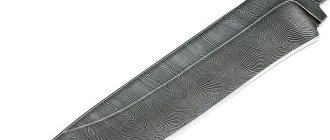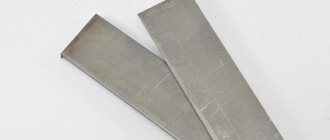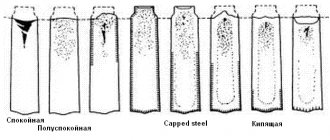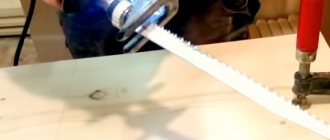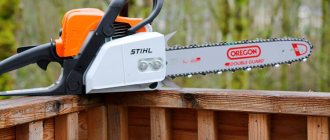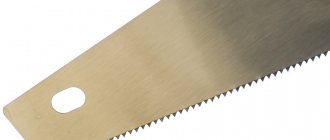All these knives were made by , on whose premises our production is located.
So before there were fewer problems in choosing a knife. This is due to weak supply on the market: there was not such variety in steels, handle materials and manufacturers.
With this article I give the beginning of a short guide to choosing a knife; the help will be divided into four parts:
What is damask steel and what is Damascus: differences between steels
To bring non-specialists up to speed, let's look at these two types of patterned steels separately. So:
Damascus
The translation of the word "Damascus" from Arabic sounds like water. This is due to the fact that blades made of high-quality Damascus resemble the surface of rippling water. This explanation is one of several options for the origin of the name of this metal. In essence, it is a package of steels of various grades, repeatedly forged by forging. The number of layers of modern Damascus can reach 150, 300, 600 or more.
Bulat
The smelting of modern damask steel is carried out by many workshops, and the result of their work is often difficult to attribute to damask steel. This article deals only with damask steel produced in the workshop of Sergei Baranov. The technology for producing this metal is based on archival workbooks of the great Russian metallurgist Pavel Petrovich Anosov. It was he who, in the 30s of the 19th century, received the first Russian damask steel, which was in no way inferior to the legendary patterned metal of antiquity.
Sergei Baranov's cast damask steel is obtained as a result of crucible remelting of a charge consisting of a mixture of special additives and steel grades: EI-107 and Kh12MF. Complex technology of long-term melting, special cooling and heat treatment methods make it possible to give the blades high hardness.
| Damask steel knife | Damascus steel knife |
Advantages and disadvantages
The special properties of Damascus steel, a kind of saw along the edge of the cutting edge, are a consequence of the presence of soft and hard grades of steel in the package. Depending on the original composition of the package, Damascus can be corroded or weather-resistant. Typically their Damascus blades have a hardness of 57-59 HRC.
The special properties of damask steel are high hardness combined with viscosity and strength. A damask knife with a hardness of 62-64 HRC has a strong cutting edge that is not prone to chipping. In addition, Baranov’s damask steel is not subject to corrosion.
Now let’s look at the main misconceptions associated with powder steels.
- What kind of steel is it, does it contain 3% carbon?
The steel/cast iron boundary at 2.14% C comes from the FeC diagram and corresponds to the appearance of eutectic under equilibrium conditions. Previously, this boundary passed at 1.7% C and corresponded to the boundary at which steel was still forged under normal conditions. Please note that this applies only to UNALLOYED steels. For high-alloy steels, everything is completely different. - Powders are produced using amorphous alloy technology.
The error is associated with the similarity of the powder process and one of the technologies for producing amorphous alloys. In fact, there are fundamental differences, primarily in the compaction mode. As a result, powder steels have a normal structure with some features that we have already discussed. - Powders for a working knife are not suitable; they are as fragile as glass.
Powder steels come in different types, with different compositions and properties. And if this statement is partly true for ultra-high-alloy steels such as HAP 72, then, for example, CPM3V is known as one of the most resistant steels to extreme loads. As a rule, “powders” are noticeably superior in mechanical properties to steel of the same composition obtained by conventional processing. - Blades made from these steels are immediately sintered in a shape close to the final product.
Here again there is confusion with technology. Unlike products for structural or functional purposes obtained in this (well, almost this) way, powder steels are produced using the technology described above. - Powder steel is the highest achievement of modern metallurgy.
And here everything is not quite the same. First, powder technology has been around for a long time, and many powder steels have been in production for over 30 years. Secondly, powder processing solves only one problem, and modern metallurgy has a little more of them. But among the materials on the market, powder steels actually have a very good combination of properties.
Author: Alan Balikoev
We thank the editors of the magazine “Prorez” for the material provided.
Which knife should you choose?
Which knife to choose for hunting or kitchen? This question is asked by everyone who has decided to buy a reliable assistant. Even though I was born at the end of the Soviet Union, that little shop near the factory with half-empty display cases and coupons issued for buying groceries is forever in my memory. But there were always plenty of knives in our city - Vorsma, remember a cheap folding knife with a plastic handle and with a “Cockerel” in the form of an emblem.
All these knives were made by , on whose premises our production is located.
So before there were fewer problems in choosing a knife. This is due to weak supply on the market: there was not such variety in steels, handle materials and manufacturers.
With this article I give the beginning of a short guide to choosing a knife; the help will be divided into four parts:
- Choice of blade steel.
- Choosing a knife handle.
- Choice of scabbard.
- The shape of the knife and its purpose.
The first part, as expected, is devoted to the most important thing in a knife - steel. A knife is designed to be used for cutting. This is an axiom. By choosing the right steel, you will always be satisfied with your knife.
Advantages of powder technology.
- Due to the small sizes and close to ideal distribution of carbides in powder steels:
- You can significantly increase the degree of alloying (accordingly, “push” more carbide phase into the steel) and thereby increase the resistance properties of the steel (Fig. 2);
- By reasonably limiting the amount of carbide phase, better mechanical properties are achieved;
- Powder steels are much better at grinding (sometimes by an order of magnitude) and forging;
- When steel is hardened, a more saturated solid solution, finer and more uniform grain is obtained, which contributes to a slight increase in hardness, heat resistance, mechanical properties and corrosion resistance.
- Powder technology makes it quite easy to produce high-nitrogen steels using solid-phase nitriding methods (for example, Vancron 40/50 and Vanax 35/75 steels).
- Powders can be used to create materials using mechanical alloying methods (carbide steels, cermets, DUO steels).
Choosing steel for a knife
I will try to give you only the necessary knowledge that you need to rely on when choosing steel for a knife. I will omit the chemical compositions of steels and some technical characteristics. You don’t need to know them; manufacturers need to know them. In any case, you can easily find this information on the Internet.
Each blade must have certain user characteristics, so we need to pay attention to them. I gave each steel a rating on a 10-point scale in terms of these characteristics (hardness, strength, etc.) The result: the higher the rating, the better the steel in my opinion.
Determining the best steel for a knife
So, having determined each steel its rating on my scale, the following comes out:
1st place - Knives made of steel S390. In principle, this is predictable, since S390 is a powder metal, and powder metallurgy has stepped far forward. In terms of three most important consumer indicators, this metal is unrivaled. The only disadvantage of this steel is the high PRICE, which is due to the complexity of manufacturing and the Euro exchange rate, since the metal is imported.
Disadvantages of powder technology.
- Powder processing expands, but does not eliminate alloying limits. For example, the powder process has virtually no effect on the size and morphology of primary carbides (they are present in steels such as CPM10V, CPMS90V, etc.). An increase in the amount of primary carbides leads to rapid degradation of the mechanical and technological properties of steel (for example, CPM15V). There is also a lower limit: if the steel does not have eutectic carbides in its structure, then powder processing does not make sense and often leads to some deterioration in properties.
- Powder steels, as a rule, have more non-metallic inclusions (although this is successfully combated).
- Powder steels have become noticeably more expensive (relatively low-alloy steels are approximately three times more expensive, for high-alloy steels the difference is less). Their production requires expensive equipment, and the maximum size of workpieces is limited.
It is necessary to understand that powder processing is not a magic wand. It solves one problem: it fights carbide heterogeneity. It is most appropriate to produce high-alloy steels (for example, high-speed or corrosion-resistant) by this method, where the improvement in durability, mechanical and technological properties compensates for the increase in cost.
Basic parameters of Kh12MF steel and operating rules
X12MF is a steel grade that is an alloy of several elements. The presence of chromium, carbon and vanadium makes the metal hard and durable. Since steel of this grade is not resistant to corrosion, it will be necessary to regularly care for the metal - immediately after use, wash, dry and treat with petroleum jelly.
X12MF has foreign analogues - American steel D2 and Japanese SDC11; they are completely identical in composition and have the same quality characteristics. The availability and low cost of the X12MF have made it popular in the production of hunting, tactical and tourist knives. They are sold at prices ranging from 3 to 15-16 thousand rubles and this is the cost of products from well-known brands.
Material cost
The cost of the material is affordable because it is cheap to produce and is often made from recycled materials. Therefore, knives made of X12MF alloy, even from the most famous brands, have a completely reasonable price - from 3 thousand rubles to 15-16 thousand.
We recommend reading the article about German bayonet knives. From it you will learn about famous products of German bayonet knives from the Second World War, the characteristics of the Mauser 98k bayonet knife, as well as how much a German bayonet knife costs and where you can buy it.
Here's more information on how to choose the best switchblade.
X12MF steel and knives made from it can last a long time, but only with proper care and use. It is difficult to find kitchen cutting tools made of such an alloy on sale, but artisans are actively offering hunting, tactical and tourist items on the market.
X12MF steel: characteristics
X12MF is a steel that was developed, created and put into production in the 30s of the last century. Initially, the metal was positioned as a tool alloy, optimally suited for cold deformation. The quality characteristics of steel are high, which makes it popular in modern production.
Initially, X12MF grade steel was intended for the manufacture of “knife blades”; this term meant cutters and stamps for printing, technological cutting tools for woodworking, saws, and so on. But already in the 50s of the last century, artisans began to use metal to make knives for household and kitchen purposes.
And here is more information about the types of combat knives.
Properties, chemical composition
The high quality and properties of steel are ensured by its complex chemical composition:
- chromium up to 12.5% - this substance has a direct effect on the ability of the metal to harden, increases the anti-corrosion properties of steel and the level of wear resistance of the finished product;
- vanadium 1.1% - has the highest possible strength, enhances the properties of chromium, makes steel inert in relation to aggressive environments;
- carbon 1.6% - gives the metal special strength, reduces the level of fragility;
- molybdenum up to 1% - refers to hard-melting elements, increases the metal’s resistance to mechanical stress, makes it resistant to high temperatures;
- silicon and manganese up to 0.6% - make steel stable, reliable, and maximize the hardness of the metal.
The composition also contains sulfur and phosphorus - these are harmful technological impurities that can increase the fragility of the metal and reduce the overall physical and chemical properties of steel. But in such a negative quality, sulfur and phosphorus “work” if a large amount of carbon is present in the metal. In the X12MF brand, the proportions of the latter element are low, the harm from the presence of sulfur and phosphorus in the chemical composition is minimal, practically undetectable.
Production nuances
The production of X12MF steel in industrial quantities is carried out according to a well-developed technological algorithm, necessarily taking into account some features:
- The melt is poured into a ready-made mold at the customer’s request. Allowances for subsequent technological processing of the workpiece must be taken into account.
- The annealing stage is required because when the metal cools, dendration of the material occurs. And this leads to uneven precipitation of carbides, which disrupts the homogeneity of the steel structure.
- At the forging stage, the quality characteristics of the metal continue to improve - the heterogeneity of the structure completely disappears, the “grain” is refined, and all voids in the crystal lattice are filled.
Watch the video about the X12MF fragility test:
Experts especially highly value steel grade X12MF, obtained by smelting by electroslag or vacuum-arc remelting (ESR and VAR, respectively).
Features of the chemical compositions of alloys
In both alloys created on the basis of iron, the following are present in small proportions: silicon, sulfur, copper, manganese, nickel, phosphorus.
The carbon content in them is different: in 95Х18 - on average 0.95%, and in Х12МФ - 1.5%, which affects the properties of the metal. An increased content of the component increases strength, but complicates forging.
The composition of alloying elements, which add uniqueness to the properties of steel, is also somewhat different. Thus, in X12MF vanadium, tungsten, and molybdenum are used as additives. The latter provides the alloy with uniformity and homogeneity, which is very important for cutting tools.
X12MF steel for knives: pros and cons
The advantages of X12MF steel include:
- Production is cheap - the composition includes readily available components at low cost, and the metal is often made from recycled materials. As a result, the low cost of knives with a blade made of X12MF steel.
- The performance characteristics of the knife are completely predictable. If you follow all the rules for caring for metal and its use, then even constant exposure to a wide range of temperatures will not reduce its properties.
- The sharpness of the knives is perfect. Optimal sharpening angles coupled with high metal hardness (HRC 63-64 units) provide the edge with high wear resistance. The sharpness of the blade is maintained for a long time even with active use of the tool.
- Maintenance of cutting tools made of X12MF steel is minimal. The fact is that metal practically does not rust, so there is no need to constantly polish it, coat it with any specific coating or constantly soak it with anti-corrosion liquids.
If we talk about the disadvantages, then you should pay attention to the following:
- It is almost impossible to carry out any technological operations with steel related to heat treatment at home. During forging, the metal workpiece cracks, and if heating to the required forging temperature does not occur, the steel will simply crumble.
- To sharpen the cutting edge of the blade, you will need special equipment.
- Bending loads can only be minimal. Therefore, knives with a blade limited in length are made from the steel grade in question.
- With frequent contact of metal with salts and acids, so-called pitting corrosion begins to appear.
- A blade made of X12MF steel will never shine - it will not be possible to polish it. The knife will always look dull.
- In the field, even straightening a knife can become a problem, because the metal is very hard and for this you will need a special tool such as a diamond-coated grinder.
Budget level of steels
The cheapest and most unpretentious knife steels from the first group are Chinese stainless steels 8cr13mov, 9cr13mov, 440c, and tool d2. What’s funny is that the Chinese often put 8cr13mov everywhere, declaring whatever their heart desires. I emphasize that this applies only to the budget level. The steel is unpretentious, ductile, dulls once, sharpens twice. On the plus side it is very affordable. It must be said that even the inherently good 440c and d2 on Chinese knives often do not reach the quality of similar steels on branded ones. Either a bad thermal or the playful hands of the Chinese.
This steel is characterized by aggressive cutting and good ductility, although the thin cutting edge does not like excessive loads and causes chips. D2 is quite easy to edit with ceramic abrasive stones without requiring the purchase of expensive diamond hones. In the field, the sharpness of the knife can be adjusted using waterproof sandpaper. Ceramic musat is suitable for quick straightening.
Carbons are carbons, they rust easily, pick up a sharp edge well, and cut aggressively and for a long time. From this category, I prefer carbon steels; maintenance is not difficult, and it’s more pleasant to work with.
X12MF or 95x18 - which is better
The most important advantage of steel grade 95x18 in comparison with X12MF is its complete resistance to corrosion, which is much better for constant use. The knife can even withstand constant contact with water and juices of vegetables and meat, so it will be optimal for working in the kitchen.
Comparing two grades of steel X12MF and 95x18, determining the best is not entirely correct, because the working properties of the metals vary too much.
For example, steel 95x18 has the following quality characteristics:
- stainless steel;
- holds an edge well;
- hardening at the level of 57-59 HRC units.
Watch the video about hardening 95Х18 and Х12МФ:
Is Damascus better?
But when asked whether Damascus is better than X12MF steel, experts give an unequivocally negative answer. The fact is that Damascus steel has practically no resistance to corrosion processes; it rusts even with slight, infrequent contact with water. This makes it necessary to follow the rules for caring for knives made of such material - be sure to dry them, regularly treat them with special liquids, and polish them.
High level of steels
But not all powder steels cause trouble when sharpening. For example, M390 is an excellent tool stainless steel produced by the Bohler-Uddeholm Corporation. Steel exhibits its properties best at a hardness of 60-62 Rockwell units. It has a high level of corrosion resistance and very high wear resistance. At the same time, knives can be sharpened quite easily using ceramic abrasives, although, of course, the sharpening process is faster with the help of diamond stones. Steel also has good mechanical properties to prevent chipping on the cutting edge, for example, when it hits a bone during cutting.
Where to get X12MF steel at home
X12MF steel is sold at metal depots in the form of rods of various calibers and strips. In everyday life, it can be taken from various machines - woodworking, metalworking. Gears and cutting parts for them are made of X12MF steel.
The same grade of metal is used in the manufacture of:
- souvenir, hunting knives - you can use an old tool with a broken handle;
- rollers for production machines;
- body stamps - you can look for them in old forges, fur. yards
Mechanical and chemical properties of Elmax steel
Having considered the relationship between composition and characteristics, we can highlight the Elmax alloy. It contains molybdenum, vanadium, chromium. Thanks to this, the blade sharpens well and does not corrode for a long time.
This steel is very clean, as it does not contain phosphorus and sulfur, which degrade the quality of the alloy.
Chromium is 17.8%, carbon is 1.72% , so Elmax is high-carbon. Alloying elements are:
- vanadium, it increases hardness and strength;
- silicon helps maintain viscosity;
- molybdenum increases elasticity and helps resist corrosion and oxidation resistance at high temperatures;
- nickel makes knives more flexible and also resists corrosion;
- tungsten makes products less fragile;
- magnesium also improves product performance.
Elmax steel knives are great for the kitchen; interaction with moisture does not impair their properties.
Knife Uzbek-3 (powder steel ELMAX).
Analogs
The most famous foreign analogue of X12MF steel is grade D2. The metal is produced by the Americans; their chemical composition is identical; in the Russian version, the chromium content is even slightly higher. Some sources claim that D2 is many times superior to X12MF in terms of quality characteristics and cutting edge sharpness, but experts say that this is a purely subjective opinion of the “like/dislike” type.
Another foreign analogue is Japanese-made SCD11 steel. It is used for the manufacture of knives that have to be used in conditions of increased wear.
The Japanese analogue X12MF is different:
- strength;
- high level of impact strength;
- excellent cut;
- high carbon content;
- maintaining sharpness even after extreme cuts using power cutting.
Of the Russian steel grades, Kh6VF, Kh12VM, Kh12F1 are considered analogues. But they are more likely to be substitutes with lower characteristics of metal hardness and sharpness. But steel of these grades is resistant to corrosion, which is why knife manufacturers often prefer them.
Average level of steels
The choice in the middle price segment is much wider and more interesting in terms of consumer properties. Among domestic steels, it is difficult to ignore x12MF; firstly, the steel itself, despite its advanced age, is very popular due to the aggressiveness of the cut, ease of sharpening, and good wear resistance. Yes, it is prone to rust, but simple maintenance solves this problem. Secondly, after etching the blade, a clear damask steel-like pattern appears on it, which makes it possible for unscrupulous sellers to sell knives made of x12MF at the price of damask steel. Stainless steels 100x13M and 110x18mshd demonstrate decent performance at an adequate cost. The latter is close in properties to the foreign 154CM.
Among imported stainless steels, it is worth mentioning the Japanese VG10, as a rule, found on Spiderco or Coldsteel knives, as well as on Fallknivens and N690. Which in principle is very close, only the second steel is made in Austria. A very good average in the world of steels, it is well processed by, for example, the Southern Cross, it is characterized by good retention of the cutting edge, decent mechanical properties, and excellent corrosion resistance.
In this price group it is already quite possible to buy knives made of 154CM/RWL34/ATS34 - excellent stainless steel, with an aggressive cut, long-term retention of the sharpness of the cutting edge and at the same time, easy and simple to sharpen. With some luck, you can buy powder steels like Elmax, and this is a completely different way of maintaining the sharpness of the cutting edge. Moreover, ordinary ceramic abrasives are suitable for sharpening.
Knives made of steel X12MF
Kitchen knives made of X12MF steel are rarely made; more often you can find hunting tools on sale. The brand in question is often used for the manufacture of Yakut knives.
"Bakhycha"
This is a small knife with the following characteristics:
- the blade is wide;
- handle 115 mm;
- blade 110x36x4 mm;
- handle material – walnut;
- the shape of the descent on the blade is straight;
- type of sharpening - one-sided.
Cutting knife made of X12MF steel.
The handle has duralumin elements that serve both as decoration and as a device for striking. The tool is lightweight and fits comfortably in your hand. The “Bakhycha” knife is especially often used for skinning animals and for cutting meat and fish.
"Cervical"
Such a knife is considered universal because it can be used to perform various business operations - cutting, making holes in non-solid material, cutting meat/fish.
Product quality characteristics:
- handle length – 110 mm;
- blade parameters – 110x22x4 mm;
- the handle is made of Karelian birch (stabilized);
- The bolster is made of cupronickel;
- the descent on the blade is straight;
- sharpening is one-sided.
“Neck” knife made of X12MF steel
The name “neck” knife was given by the type of wear - a sheath and a loop made of genuine leather allow you to wear it around the neck.
"Hotonoh"
This Yakut knife has a narrow blade 179 mm long, it also has a second name - “tundra”. The blade is made of steel X12MF, the handle is made of Karelian birch. The sharpening is standard one-sided, the descent on the blade is straight. The cutting tool is used in hunting; it is excellent for deboning meat and cutting fish.
The Khotonokh knife is sold together with a sheath made of genuine leather; before sale, it undergoes a test protocol and has a quality certificate. The manufacturer guarantees its product for 12 months of proper use.
"Bychakh"
This is a Yakut tundra knife with a narrow blade and belongs to the category of universal cutting tools. Product characteristics:
- steel hardness – 62 HRC;
- metal – forged, alloy grade X12MF;
- handle length – 135 mm;
- blade parameters – 150x25x4 mm;
- handle material – birch bark and wenge;
- Pritin is made of duralumin;
- sharpening of the cutting edge is one-sided;
- The descent on the blade is straight.
Yakut tundra knife made of X12MF steel.
Such a long blade is convenient for cutting animal carcasses and fish; it can also cut soft materials and even make holes.
What criteria must steel meet?
In order for the blade to remain strong and reliable for a long time, steel grades for knives must meet certain requirements:
- high hardness;
- wide operating temperature range: from -300 to +1000 degrees;
- strength, guaranteeing minimal deformation under mechanical stress;
- increased elasticity;
- corrosion resistance;
- the ability to maintain sharpness for a long period.
Failure to meet quality criteria directly affects the performance of the cutting tool. Consequently, the effectiveness of completing assigned tasks will be impaired.
The hardness of the alloy is standardly designated by the abbreviation HRC. In Europe, this parameter is abbreviated as RC. It is usually determined using the Rockwell scale, with 54-57 units taken as the standard. However, in reality, such blades quickly wear down, and their sharpness must be restored with a grinding stone. In Japan, the hardness of the blade exceeds HRC 59. Such blades remain sharp for a long time. They cannot be treated with musat; the blade begins to crumble. For sharpening, a special technology is used, which is based on the rules regarding the use of soft grinding wheels. The optimal blade hardness exceeds HRC 55.
Each country has individual markings for the steel from which knives are made.
| USA | Germany | Russia | Japan |
| 420 | X21Cr13 | 3X13 | SUS42011 |
| 420/425 Mod | X45CrMoV15 | 4X13 | SUS42012 |
| 440A | X15CrMoV15 | 65X13 | AUS6 |
| 4408 | X89CuMoV181 | 9X18 | AUS8 |
| 440C | X105CrMo17 | 95X18W | SUS440C |
How to care for a knife made of steel X12FM
Caring for a knife made of X12MF steel is as follows:
- after use, the product is washed with water;
- after each “water procedure” the blade must be dried (you can wipe it with a paper napkin);
- The blade must be lubricated with petroleum jelly after each use;
- Once every 120 days, the blade is polished with GOI paste and trimmed on a leather belt;
- the wooden handle should be periodically treated with an antiseptic against mold and bacteria;
- If traces of corrosion appear on the blade, they must be immediately wiped with ballistol.
In order for the service life of knives made of X12MF steel to be long, the following rules must be observed:
- do not throw, throw the knife or use it as a lever;
- do not allow the blade to enter an acidic or alkaline environment;
- maintain a sharpening angle of 35 degrees when dressing the tool.
Watch the video on how to get rid of rust on X12MF steel:
Differences in material composition
Any grade of steel contains a mixture of iron and carbon. To improve its characteristics, alloying elements are also added:
- chromium – protects products from corrosion;
- nickel – enhances strength properties and prevents metal from rotting;
- manganese - allows you to make the blade of the desired shape. Allows metal forging;
- vanadium – increases strength, increases service life;
- silicon – creates high strength;
- tungsten – enhances corrosion properties, increases strength indicators.
The carbon concentration determines the type of metal. He can be:
- low carbon;
- medium carbon;
- high carbon.
If additional chemical elements are included in the alloy, it becomes alloyed. When the concentration of these substances exceeds 10-50%, the steel is called high-alloy.
To increase the strength of the metal and give it additional toughness, alloying with molybdenum is carried out. For example, in Japanese blades its concentration is 8%.
The blade becomes harder with vanadium and tungsten additives (8%). If the chromium concentration exceeds 13%, cutting characteristics improve and the blade becomes resistant to rust.
Stainless steel for knives 440C deserves special attention. The blade retains its original sharpness for a long time. When the molybdenum concentration is 4%, the alloy is elastic and wear resistance is greatly improved. A striking example of such material is BG-42.
Methods and methods of sharpening
Even high-speed steel P12 is subject to wear and dullness, despite its impressive strength properties. If we take into account the information about the use and properties of this alloy, then we can safely say that it will not be possible to sharpen them using grinding wheels from electrocorundum: the surface after such treatment still remains rough, and the cutting qualities do not improve.
The most correct option would be to take the knife to a specialized workshop for sharpening, which has CBN wheels at its disposal. Having such cars in your garage is an unaffordable luxury and simply not advisable.
You can, of course, try sharpening at home, but it’s worth considering: at a minimum, this will require diamond stones, the prices of which have been very high lately. In this case, processing will be carried out in 2 stages:
- First, use a stone with a large grain - the so-called coarse sharpening.
- Then use a fine-grain abrasive for final sanding.
It is better not to try to sharpen it in a garage, as there is a chance of damaging the tool beyond its original state.
Rating of the best views
To determine the best types of steel for a knife, it’s a good idea to study their characteristics. Let's look at existing brands with a detailed overview of their qualities.
Imported
It is difficult to answer unequivocally which steel is better for a knife. Large manufacturers of this cutting tool use special Slava grades, a material of their own design. Of course, the regional factor is also important: each state has popular types of steel with its own specifications.
Powder steel, manufactured in Austria. Medical instruments are made from this alloy. The hardness of the metal reaches 58-62 HRC. Knives differ from similar ones in a number of positive qualities:
- Corrosion resistance.
- Wear resistance.
- Long lasting sharpness.
This alloy can be easily replaced with American high-chromium steel Duratech 20CV, which has identical performance.
ELMAX
Another Austrian knife steel. The first batches of powder tool grade were used for cutting parts installed on machines processing plastics. Among the advantages of this material:
- Corrosion resistance.
- Easy sharpening.
- Strength.
The cutting edge does not lose its sharpness for a long period. The material is most often used for blades. The hardness of the blade reaches 58-62 Rockwell units. The composition is similar to the 440C alloy grade. The only difference between the latter alloy and ELMAX is the vanadium content. Disadvantages - breaks under heavy loads.
Used in the USA, tool steel. Suitable for high speed cutting tools. Anti-corrosion and strength characteristics allow the cutting edge to remain extremely sharp for a long time. The hardness of the alloy can reach 61 units. X12MF - Russian analogue. X155CrVMo12-1 is an identical steel grade common in Germany.
CPM S30V
Stainless steel grade comes from America. The powder alloy contains vanadium carbide, which increases strength and improves cutting properties. The quality of products made from this material is superior to analogues made from grade 440C. The cutting edge does not chip and very rarely crumbles. Well-known companies make knives from this material:
- Buck Knives;
- Spyderco;
- ZT Knives (Zero Tolerance);
- Str >This steel was called the “gold standard”. High-class cutting tools are made from it. HRC at the level of 58-60 units.
- High resistance to corrosion.
- Long-term preservation of the original sharpness.
- Quick recovery when editing.
- Impact strength.
ZDP-189
Powder steel based on a combination of chromium and carbon. This high-carbon metal, used in Japan, perfectly resists the negative effects of rust and does not deform due to impacts. The hardness of the metal in some cases reaches 69 units, so serious mechanical loads are dangerous for knives. There are no analogues.
CPM S35VN
American powder stainless steel. The metal is considered an improved modification of CPMS30V and has good impact strength. Niobium carbide is included in the molecular structure. It improves hardness by 20% compared to CPM S30V.
Read also: Melting temperature of metals table in ascending order
The blade is resistant to chipping. The knife retains its edge perfectly and is easy to sharpen. Blade hardness – 58-61 HRC.
High-carbon, corrosion-resistant steel made in Japan based on molybdenum and cobalt. Ideal viscosity allows the blade to undergo heat treatment to obtain a hardness of 60-63 units. The world's best brands make knives from this brand:
- Spyderco;
- Cold Steel;
- SOG;
- Camillus Cutlery Company;
- Fällkniven AB.
Products made from VG-10 steel have good corrosion resistance. The blades do not rust at all. The metal can be easily straightened to a razor sharpness. Retains factory sharpening for a long time.
Japanese steel with good quality of corrosion resistance. It is used in products of the world's leading companies. The blades are distinguished by high hardness (HRC 56-69). Advantages of a knife made from AUS-8:
- Mechanical endurance.
- Workmanship.
- Anti-corrosion properties.
- Sharpening duration.
- Low cost.
The AUS-8A alloy modification is actively used by the American company Cold Steel. It contains more carbon. The following alloys are considered analogues:
- 440C – USA.
- AUS-8/AUS-8A - Japan.
- AEB-L - Sweden.
- 8Cr13MoV – China.
- 95X18, 75X16MF – Russia.
American chrome steel. HRC is 58-60 units. The alloy never rusts. Folding knives are made from this material. The metal is easy to straighten even with a non-professional approach, and holds its original sharpness for a long time.
This modern alloy has become widespread throughout the world. It is considered the most expensive material. The following have similar properties:
- 95Х18 – Russia.
- X102CrMo17 – Germany.
- Z100CD17 – France.
- AUS-10 - Japan.
Domestic
In Russia, types of alloys are also presented in a wide range. The most popular, time-tested grades of knife steel are mixed materials, the characteristics of which fully meet the requirements for knife products.
X12MF
Tool steel consists of several components: sulfur, copper, molybdenum, silicon, manganese, phosphorus.
The main advantages of the alloy:
- Wear resistance.
- Anti-corrosion properties.
- Increased service life.
- Holds the initial sharpening for a long time.
- High HRC - 64 units.
If the blade comes into contact with aggressive substances, the blade becomes covered with a dark coating - this is a lack of material. Requires constant editing. The French steel grade Z160 is characterized by approximately the same qualities. It also contains tungsten.
95Х18
This alloy is considered the best in the Russian Federation. The composition includes 19% chromium, so the blade is not afraid of high humidity. The material holds its initial sharpening for a long time. Such knives are suitable for tourists and become real assistants to hunters. Z90 steel has similar parameters.
40Х12
High alloy mild steel. Designed for the manufacture of kitchen knives, as well as souvenirs. The material cannot be hardened to high hardness (HRC - 52 units). The products are soft, bend easily, and the knives quickly become dull. Since the blades practically do not rust, they do not require additional maintenance, they can be safely used for work in the kitchen.
65Х13
Inexpensive stainless steel. Maximum hardness 58-59 HRC. Main positive qualities:
- Impact resistance.
- Resistance to high humidity.
- Easy to sharpen.
- Anti-corrosion properties.
Surgical instruments and hunting knives are made from the alloy. Material 1K6 has similar properties.
50Х14МФ
The composition of the metal includes substances that affect its properties:
The material is resistant to high humidity and does not react with chemicals. The alloy is not afraid of strong impacts and is easy to sharpen. Foreign steels have similar qualities:
Specifics of the material and its general characteristics
The name P12 is not a simple set of letters, but a marking that contains some information about the alloy:
- “P” - all high-speed steels are marked with this letter, from the English name rapid (speed);
- 12 is the percentage of tungsten in the metal, which forms very hard chemical compounds - carbides, which sharply increase strength and red-hardness.
Quick cutters have long been used to create edged weapon blades, due to their following characteristics:
- good hot hardness, which characterizes what temperature steel can withstand without loss of performance;
- increased red resistance - indicates how long the alloy will withstand this temperature;
- Great resistance to wear and external loads.
As a result, knives made from P12 will have strong blades that can easily withstand severe mechanical stress without deforming the structure of the product.
High hardness is a characteristic feature of such cutting tools; this important property affects both the service life and the quality of the cut. Although such an alloy can withstand bending loads, its weak point is increased fragility, since the hard metal is susceptible to brittleness.
